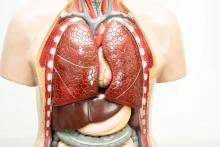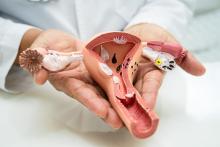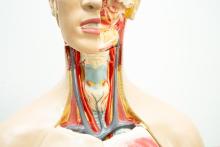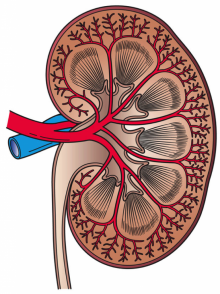חדשות המחקר

Andrei Braester, Jacob Bornstein, Andrei Zverev, Yvgeny Kukuyev, Masad Barhoum: Reassessment of Venous Thromboembolism Risk and Prophylaxis in Postdelivery Period of Healthy Women (Am J Med Sci .)
We conducted a prospective study to determine if the combination of pregnancy and surgical delivery (SD)/cesarean section (CS) is a stronger triggering factor for thromboembolic events than the combination of pregnancy and vaginal delivery (VD). This issue relates to the fact that VD and SD/CS are by themselves thrombophilic triggers.

Bedside score predicting retained common bile duct stone in acute biliary pancreatitis (World J Clin Cases.)
Retained common bile duct (CBD) stone after an acute episode of biliary pancreatitis is of paramount importance since stone extraction is mandatory. The aim of this was to generate a simple non-invasive score to predict the presence of CBD stone in patients with biliary pancreatitis. (Tawfik Khoury, Anas Kadah, Mahmud Mahamid, Amir Mari, Wisam Sbeit)

Routine Uterine Culture Swab During Cesarean Section and Its Clinical Correlations: A Retrospective Comparative Study (Eur J Obstet Gynecol Reprod Biol . )
Cesarean sections, particularly non-elective cesareans, are an important risk factor for the development of postpartum endometritis, a leading cause of postpartum febrile morbidity. We evaluated the yield of obtaining routine intrauterine culture during elective and non-elective cesarean sections, in the prevention and management of postpartum endometritis. (Inshirah Sgayer, Tomer Gur, Daniel Glikman, Hagai Rechnitzer, Jacob Bornstein, Maya Frank Wolf)

Ohad Ronen, Hector Cohen, Eyal Sela, Mor Abu: Differences in Cytopathologist Thyroid Nodule Malignancy Rate (Cytopathology .)
The accuracy of a cytology diagnosis obtained by fine needle aspiration (FNA) is influenced by several factors such as the technique used and the experience of both the aspirator as well as the cytologist. In this trial we planned to evaluate the interobserver differences of thyroid nodule cytopathology in our medical center

Mohammad Adawi, Arnon Blum: Sleep Disorders and Vascular Responsiveness in Patients With Rheumatoid Arthritis (J Intern Med .)
Rheumatoid arthritis (RA) is the most common systemic autoimmune disease characterized by chronic systemic inflammation. Half of the deaths of patients with RA are due to cardiovascular diseases (CVD). Patients with RA also experience poor sleep, which by itself is associated with endothelial dysfunction, CVD events and sudden death. OUR AIM: was to study the mechanistic pathways and the correlations between sleep efficiency and vascular reactivity of patients with RA.

Amir Mari, Tawfik Khoury: Salivary pepsin for the diagnosis of gastro-esophageal reflux disease: any role in 2020? (Minerva Gastroenterol Dietol .)
In Minerva Gastroenterologica e Dietologica

Resection of an Axillary Macrocystic Lymphatic Malformation in a 14-year Old Female Using Intraoperative Indocyanine Green Lymphography (J Vasc Surg Venous Lymphat Disord)
Lymphangioma is a malformation of the lymphatic system, for which surgical excision is a possible treatment. However, complete excision may be hindered by the lesion's size, anatomical location, unclear borders and invasion to adjacent tissues. We describe a 14-year old girl who presented with a rapidly progressing axillary swelling. MRI and US revealed a lymphatic macrocystic multilocular lesion. Following pre- and intraoperative indocyanine green lymphography, a complete surgical excision was achieved without damage to collateral lymphatic channels or surrounding tissues. Intraoperative indocyanine green lymphography may be useful in achieving efficient and safe resection of lymphangioma without damaging unconnected lymphatics. (Assi Drobot, Samer Ganam, Nour Karra, Amitai Bickel, Ibrahim Abu Shakra, Eli Kakiashvili )

O Ronen, E Sela, L Degabli: The effect of bleeding on children's haemodynamic indices: an analysis of previous post-tonsillectomy bleeding cases (J Laryngol Otol.)
Post-surgical bleeding after tonsillectomy occurs in 2–7 per cent of cases. This study examined whether heart rate and haematocrit changes are associated with the amount of bleeding.

Enav Yefet: A Randomized Controlled Open Label Crossover Trial to Study Vaginal Colonization of Orally Administered Lactobacillus Reuteri RC-14 and Rhamnosus GR-1 in Pregnant Women at High Risk for Preterm Labor (Nutrients .)
Lactobacilli administration has been suggested for the treatment and prevention of bacterial vaginosis, which increases the risk for preterm birth. We aimed to evaluate the vaginal colonization of lactobacilli orally administered to pregnant women at risk for preterm birth.

Andrei Braester: Severe Renal Impairment and Risk of Bleeding During Anticoagulation for Venous Thromboembolism (J Thromb Haemost .)
Detection of severe renal impairment in patients with venous thromboembolism (VTE) is mandatory both for selecting anticoagulant therapy and for evaluating major bleeding risk, increased by severe renal impairment. The objective of this study is to determine whether the Cockcroft and Gault (CG) and Chronic Kidney Disease Epidemiology Collaboration (CKD-EPI) formulas identify severe renal impairment in the same VTE patients presenting the same risk of major bleeding.

Chaim Putterman: Cognitive Dysfunction in Autoimmune Rheumatic Diseases (Arthritis Res Ther)
For people with chronic autoimmune rheumatic diseases (AIRD), such as rheumatoid arthritis (RA), systemic lupus erythematosus (SLE) or systemic sclerosis (SSc), normal cognitive functions are essential for performing daily activities. These diseases may be associated with cognitive dysfunction (CD). In RA, CD has been associated with age, lower education and disease duration and activity. Great advances have been achieved in neuropsychiatric SLE in the identification of pathogenic pathways, assessment and possible treatment strategies. SSc rarely exerts direct effects on the brain and cognitive function. However, the psychological burden that includes depression, anxiety and social impact may be high. AIRD patients with sustained disease activity, organ damage or lower education should be evaluated for CD. The control of systemic inflammation together with tailored behavioural cognitive therapies may benefit these patients.

Avi Benov, Elon Glassberg: Prehospital Definitive Airway Is Not Associated With Improved Survival in Trauma Patients (J Trauma Acute Care Surg .)
The American College of Surgeons and the National Association of Emergency Medical Technicians advise securing a definitive airway if there is any doubt about the trauma patient's ability to maintain airway integrity. The objective of this study was to investigate the association between a success in securing a definitive airway in the prehospital setting and survival among trauma patients, in which the provider deemed a definitive airway was necessary.

Andrei Braester, Luiza Akria, Orly Yakir, Liron Shelev, Masad Barhoum: Blood Myths and Ethnic-Cultural Background as Impediments in Patient Blood Management Education (J Relig Health .)
A significant percentage of red blood cell transfusions (RBCTs) are the result of overuse. The implementation of patient blood management (PBM) is challenging. We examined whether blood-linked myths and ethnic-cultural background factors are impediments to PBM education and implementation.

Eli Kakiashvili: Robotic Inguinal Hernia Repair: Is It a New Era in the Management of Inguinal Hernias? (Asian J Surg .)
Compares outcomes of elective inguinal hernia repair performed at one institution by three approaches: robotic-assistance, laparoscopic, and open.

Rola Khamisy-Farah: Vaccines Are Underused in Pregnancy: What About Knowledge, Attitudes and Practices of Providers? (Acta Biomed .)
Investigates actual knowledge of official recommendations towards seasonal influenza (SID), and Tetanus-diphtheria acellular-pertussis (Tdap) vaccines in obstetrics/gynecologists (OBGYN).



